If it was not clear from my previous posts on our trip to Ecuador (read them here), I truly fell in love with this small but biodiverse country. Because of its recent history and people’s ideas about what it is like, tourism is still down in this amazing place. Many countries are overrun with tourists, which lends a Disneyland-ish feeling, can damage infrastructure, and can taint public opinion of tourism.
Ecuador seemed so real, full of authentic experiences. Many people visit ONLY for the Galapagos, but this country offers so much more! The lack of developed/established tourism has “disadvantages,” depending on your travel style. Less variety of accommodations, more challenges getting around, maybe less opportunities for “comfort items” for US travelers (you will be hard-pressed to find a McDonalds, although a google search says they do exist). There are sometimes rolling power outages and occasional political unrest. English was not as widely spoken as many Latin American countries, so brush up on your Spanish!
Quito was great, although the nicer restaurants were mostly just OK (small, local cafes and street food were great), and there weren’t a ton of shops. There are areas that you probably should avoid. Check for advisories here. At the time of writing (May, 2025), the US Department of State advises against travel to:
- Guayaquil: Specifically, the area south of Portete de Tarqui Avenue.
- Esmeraldas Province: Esmeraldas city and all areas north of the city.
- El Oro Province: Huaquillas and Arenillas.
- Los Rios Province: Quevedo, Quinsaloma, and Pueblo Viejo.
- Carchi and Sucumbíos Provinces: The entire provinces are advised against.
- Northern parts of Esmeraldas province: Including the city of Esmeraldas.
Ecuador MAY not be the best place for your first international trip, unless you are on a fully-organized group or private tour. But, if you are a bit more seasoned and/or adventurous, this place is a rare gem. In any case, it is always a good idea to register with STEP, the Smart Traveler Enrollment Program, so US Big Brother can find you if something goes down.
I don’t want to shout its praises too loud, because I don’t want it to change. But, for those among you craving untouched wilderness, the mysteries of nature, and relative solitude with few fellow US tourists, this could be your dream destination.
Check out pix from our Galapagos trip here.
Travel to the Islands
We flew from Quito to Seymour Airport on Baltra Island via Guayaquil. Let me take a moment here to praise the Salas VIP Lounge in the Quito airport. This beautiful lounge was huge and offered great snacks and comfy seating! It is located right next to some really cute shops, so you can pop out, buy some overpriced dresses and hats, and pop back in.
The Galapagos Islands are served by two main airports: Seymour Airport on Baltra Island (GPS) and San Cristobal Airport on San Cristobal Island (SCY), with a smaller airport, Isabela Airport (JBQ), on Isabela Island for inter-island flights. Avianca and LATAM are the two airlines that serve the islands, and we flew both. They are fine, but if you want snacks or drinks (even water), bring them. Also, upgrading to first class was pretty cheap on our trip, around $25 per person each way. Go for it, especially if you are tall!
One of our naturalist guides, Giancarlo, was with us every step of the way from Quito. We landed in Baltra and disembarked the plane via stairs. We were welcomed by a massive iguana as we walked the cactus-lined path to the airport. Be very careful when traveling to the islands- any dirt, plant matter, or animal matter stuck to you or your belongings could have potential negative impact on the ecosystem.
Nat Hab and Giancarlo handled everything for us, but if you are traveling independently there are a few things you need to know:
- Arrive at the airport early, no less than 3-4 hours before your flight.
- You will need a $20 Galapagos Transit Control Card (TCC). You can obtain this card on arrival by visiting the INGALA counter at your originating airport (Quito or Guayaquil), but I recommend pre-registering for it here, as lines can get quite long and you may have to wait for approval. You’ll still have to visit the counter to pay and pick up your card, but you’ll save lots of time by pre-registering.
- After you’ve obtained this card, you will take your luggage to the SICGAL booth where they will inspect your luggage for seeds, fruits, nuts, etc. This is extremely important to the fragile ecosystems in the islands, and you can’t check in without having this inspection. They’ll tag your bags and you will be cleared for check in.
- Now, you can check in for your flights and do the normal airport stuff.
- Upon arrival in the islands, follow the crowds. You will present your TCC and pay the Galapagos National Park Entry Fee. This fee can only be paid in cash and, at the time of writing in 2025, is $200 per adult and $100 per child.
- Now you can pick up your bags and head out to explore!
- If you are on a package tour or cruise, they will likely pick you up after baggage claim. If you are continuing on your own, click here to read about your options.
Giancarlo herded us to the public bus, which we took the pier. The island of Baltra was pretty barren, a surreal landscape punctuated by desert bushes and cactuses. We drove past a deserted US military base and a few iguanas. When we arrived at the pier, we saw our first Sally Lightfoot Crabs, which were some of our favorite critters! They are brilliantly colored in blues and oranges, and pretty large. A particularly vocal Galapagos Sea Lion directed us to our Panga boats which took us to our home for the next 7 nights, the Tip Top IV. I was surprised (and a little disappointed) that she didn’t hop on the boat with us!
We met our second guide, Karla, who was a pretty, sweet, brilliant naturalist guide whose love of her islands was evident in her descriptions, lectures, and devotion to conservation. We really hit the jackpot with our guides, who set the tone for our cruise and taught us SO MUCH!
The Yacht: The Tip Top IV
The Tip Top IV is a 38.1 meter (125 ft) luxury yacht with 10 cabins that sleeps 16 guests and 8 crew. It has 4 decks. The sun deck is a lovely place to watch the sun set, cuddle up with a good book, or hang your laundry to dry. The upper deck contains 4 cabins and an outdoor seating area. The dining room, kitchen, common living area, and relaxation area are on the main deck, and this is where you will embark, disembark, and put on your wetsuit and lifejacket. Finally, the lower deck has 6 additional passenger cabins and the crew’s cabin.
The ship has 2 panga boats to deliver passengers to and from land, kayaks, and snorkel gear. Service onboard was excellent, and food was top notch. Snacks and beverages were always available, and staff served 3 gourmet meals a day.
Cabins were cozy, and beds could be configured as twins, doubles, or kings. Storage was minimal, with a closet, two small shelves, and one bedside table. We stowed most of our things under the bed. There was a serious lack of hooks, which could easily be remedied since there was plenty of unused wall space. The walls are not magnetic like a cruise ship, so leave your magnetic hooks at home. The rooms each had an air conditioner which worked very well.
The bathroom was tight with minimal storage. They could add shelves or drawers under the sink, as this was wasted space. Luckily, the shower had rails- there were a few times I needed them due to ship movement while I was showering.
There was a lot of movement. This was a bit of a surprise for me. I got used to it after the first day, and the movement was more regular than I’ve experienced on large cruise ships. I think this was because we were often anchored at night, so the movement was due to waves rhythmically rolling in, and it pretty much rocked us to sleep.
- Our Amazing Guides
- Our Illustrious Staff
- Part of our Group on a Panga
- Relaxing on Deck
Days onboard were characterized by early mornings, 2-5 excursions per day (hiking, snorkeling, or kayaking), lots of amazing food, educational lectures, and early nights. This was a perfect week for this adventurous nerd, in that we were surrounded by glorious nature, had lots of great conversation and food, and learned so much!
North Seymour
We wasted no time getting started on our exploration! 30-40 minutes after boarding, we made our first stop! Slightly less barren than Baltra, North Seymour was covered in Palo Santo trees, Opuntia cactuses, and Frigate birds. There were also occasional boobies, sea lions, and iguanas, but this island belonged to the frigate birds.
There were 2 types of frigate birds on this island: The Great Frigate, recognized by the green sheen to their black feathers and red eye rings, and the Magnificent Frigate, with its purple sheen and blue eye rings. The most striking feature, though, belonged to the males of both species: the (sometimes) giant red gular sacs on their throats. They inflate these sacs to attract females, and it was so funny to watch their behavior. At one point, a little diva sat in the center of 4-5 males who took turns showing off their goods in hopes of winning her favor!
Courting rituals aside, these birds are assholes. The scientific term is “kleptoparasites” This means they steal from other birds- fish, other snacks, and even THEIR BABIES. They will catch their own fish and squid if it’s convenient, but otherwise they harass other avian cousins and steal their lunches. The bullies of the sky!
They are large, with wing spans up to 7.5 feet. Their shape when flying is very distinctive, with pointed wings and split tails. They glide as they search for food, and can even take power naps while flying!
After hiking for about an hour, we emerged onto a beach where we saw our first Blue Footed Booby! These iconic birds that are synonymous with the Galapagos, are cute, goofy looking creatures. I’ll talk more about them later. Several Galapagos Sea Lions (which I’ll also talk more about later), lounged, frolicked, and played on the beach and in the water. We watched them for a while, listening to their burps, grunts, and squeals.
- Great Frigate Bird
- Sally Lighfoot Crab
- Nazca Daddy
- Nazca Hatchling
- Flirty Frigates
- Waved Albatross
Espanola
Each island had its singular, standout species that ruled the roost. The stars of Espanola were the Nazca Boobies and the Waved Albatross. The former because they were everywhere, the latter because this was the only place we saw them.
We hopped off of our Panga Boats onto a rocky promontory at Punta Suarez, which was populated by beautiful, colorful creatures. We were visiting at the tail end of mating season, so the iguanas still had their mating colors of green and red. This gives them their nickname of Christmas Iguanas, due to coloration and timing (they get decked out in their sexy “outfits” around December). Lava lizards in a rainbow of colors skittered about, stopping to do a few sets of push-ups here and there. Sea lions frolicked, and Sally Lightfoot crabs scaled the rocks.
The white sand beaches were idyllic and speckled with black rocks. To be honest, some of the most beautiful beaches I’ve ever seen are in the Galápagos Islands, which was a surprise for me.
We hiked 2-3 hours through scrub brush, prickly bushes, and rocky terrain. Nazca boobies were everywhere! These guys are black and white, with large beady eyes and yellow beaks. There was one very large male right in the middle of the trail guarding two eggs. We gingerly made our way around him, observing and clicking away at our cameras. We observed Nazcas in every stage of development, from eggs to adults. We saw newborn pink-tan hatchlings (which looked a little too much like the duck fetuses of balut), larger chicks, and “teenagers.” The “teenagers” were the funniest, most awkward creatures that looked like mini-pterodactyls with their extra-long “arms” that reached the ground. They hadn’t yet developed wings- instead their “arms” were covered in soft down which looked like fur.
This was the only place we saw the Waved Albatross, the largest bird in the Galapagos. There were two, recognizable by their long yellow beak with a hook at the end, cream-white heads and necks, and brown-black bodies. They stand up to 3 feet tall with a wingspan of 7.5-8.5 feet. This was particularly special because they spend the vast majority of their lives in flight and Española Island is pretty much the only place on earth where these critically endangered birds breed!
Back on the Tip Top IV, we watched a huge pod of dolphins race alongside us, leaping and frolicking seemingly for our amusement.
Our second excursion for the day was snorkeling Gardner Bay, on the other side of Espanola. There were so many fish! I’d never snorkeled with so many, except that time in Thailand they fed the fish. This was a natural occurrence! We were surrounded by surgeon fish, hawkfish, angelfish, parrotfish, sergeant major fish, and pike fish. We saw a spotted eagle ray! Suddenly, a huge splash caught our attention and, next thing you know, we are swimming with a sea lion! This silly creature had other ideas- she dove deep to harass a shark!
We had our first wet landing on one of the most beautiful beaches I’d ever seen! We hopped off the panga boat into the pristine, clear waters and waded onto the powdered sugar white sand beach. We saw an American Oyster Catcher, a cute little bird with a red beak and red circles around its eyes, frantically racing around in the tide. Sea lions lounged about, occasionally flapping a fin in annoyance to shoo a fly. One we passed by kept burping and rearranging himself, grunting like an old man trying to get comfy in his recliner. Others frolicked in the waves. On our way back to the Tip Top, we witnessed a tortoise menage a trois! Mother Nature can be a naughty girl!

Galapagos Marine Life
San Cristobal
This was an earlier morning- breakfast by 6, off the boat by 7. We had a wet landing on a green tinted beach which looked like it has been sprinkled with fairy dust. This appearance was due to fragments of olivine crystals derived from volcanic rocks. It was quite magical and unique. The Galapagos are volcanic islands, and each is a different age. This is part of the reason each is so unique- younger lava flows are vast fields of jagged black rocks (basaltic lava). Over time, the rocks are eroded and weathered, causing them to break down. Pioneer plants come in, followed by other plant and animal life. Eventually, the rocks are broken down to sand, which has different colors based on the mineral content. I’ll get into the formation and geology more later… calm down, I know it’s exciting! But you can wait.
San Cristóbal is one of the oldest of the Galapagos Islands. We could refer to it as “Booby Island.” The “star” of this island was the Blue Footed Booby, and I’ll get the them. But we met what might be my favorite of the Galapagos birds, the Red Footed Booby. This underrated beauty probably gets less press because they are not great dancers and tend to live in trees, unlike their blue-footed cousins. But they are so pretty! They have red feet, blue beaks, and pastel coloration to their little faces.
We took a relatively strenuous hike up rocky paths and over hills, pausing to take in the lunar landscape and infinite seascape. Rocky tan mountains formed the backdrop for black lava rock formations covered in red carpet weeds and yellow succulents. I finally reached that elusive peaceful mindset I seek daily but only find when I am immersed in nature. My mind was silent and I was fully present with the love of my life, Vuong, and the expansive wilderness I crave on a daily basis.
- Red-Footed Booby
- Christmas Iguana
- Red Carpet Weed and Yellow Succulents
- Looked like the surface of the moon
- Silhouette of a Frigate
- Sleeping Beauty
Another highlight of this island was the famous Blue Footed Booby. We were privileged, lucky, blessed to observe the mating dance that endears this goofy booby to the world! I bring you the Mating Dance of the Blue-Footed Booby:
You’ll have to navigate to my Facebook page to see it: https://www.facebook.com/share/v/193KaAnwFX/
And with that, I’ll close until next time! Come back to read about the best snorkeling in the world, Lonely George, and bird sex. Lots of bird sex.


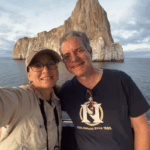





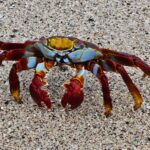
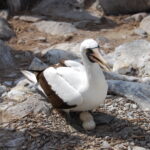







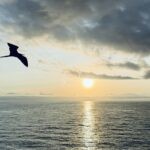

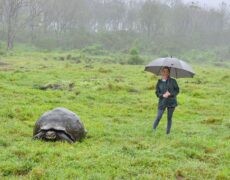


0 Comments